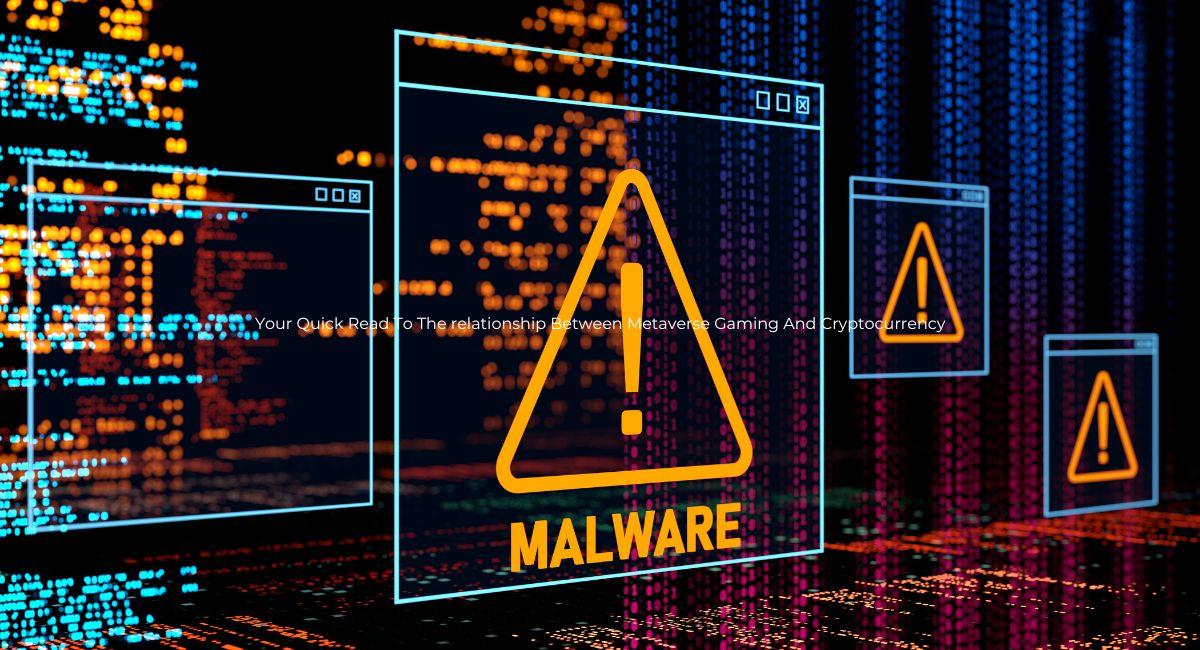 |
|
 |
|
 |
|
 |
|
 |
|
 |
|
 |
|
 |
|
 |
|
 |
|
 |
|
 |
|
 |
|
 |
|
 |
|
암호화폐의 분산화 및 가명 특성으로 인해 악의적인 금전적 이득을 위해 이러한 기능을 악용하는 은밀한 위협인 암호화 악성 코드가 생성되었습니다. 기존 악성 코드와 달리 암호화 악성 코드는 주로 암호화폐 채굴 및 도난을 표적으로 삼습니다. 분산된 운영으로 인해 추적이 어려운 반면, 조용한 운영과 전통적인 보안 조치를 회피하는 능력은 지속성에 기여합니다. 이러한 위협에 맞서기 위해서는 암호화폐 맬웨어의 진화하는 문제에 맞서 디지털 방어를 확보하는 데 있어 사전 예방적인 탐지, 교육 및 협업이 매우 중요합니다.
In the digital age, where technology connects us in unprecedented ways, the rise of cryptocurrency has introduced not only innovative financial solutions but also new challenges in the realm of cybersecurity. Among the various threats that users and organizations face, crypto malware has emerged as a stealthy adversary, exploiting the decentralized and pseudonymous nature of cryptocurrencies for malicious gain. This comprehensive exploration aims to unravel the intricacies of crypto malware, shedding light on what it is, how it operates, and crucially, strategies for detecting and mitigating its impact.
기술이 전례 없는 방식으로 우리를 연결하는 디지털 시대에 암호화폐의 등장은 혁신적인 금융 솔루션뿐만 아니라 사이버 보안 영역에 새로운 도전을 가져왔습니다. 사용자와 조직이 직면하는 다양한 위협 중에서 암호화폐 악성 코드는 악의적인 이득을 위해 암호화폐의 분산 및 가명 특성을 악용하는 은밀한 적으로 등장했습니다. 이 포괄적인 탐구의 목표는 암호화 악성 코드의 복잡성을 밝히고 그것이 무엇인지, 어떻게 작동하는지, 그리고 결정적으로 그 영향을 탐지하고 완화하기 위한 전략을 밝히는 것입니다.
The Genesis of Crypto Malware: Unveiling the Stealthy Threat Landscape

암호화폐 악성코드의 탄생: 은밀한 위협 환경 공개
In the ever-evolving landscape of cybersecurity, the emergence of crypto malware represents a sophisticated and adaptable adversary, exploiting the decentralized nature of cryptocurrencies for malicious purposes. This in-depth exploration aims to uncover the genesis of crypto malware, providing a comprehensive understanding of its origins, evolution, and the intricate threat landscape it presents to individuals, organizations, and the broader digital ecosystem.
끊임없이 진화하는 사이버 보안 환경에서 암호화 악성코드의 출현은 암호화폐의 분산된 특성을 악의적인 목적으로 이용하는 정교하고 적응력이 뛰어난 공격자를 의미합니다. 이 심층 탐구의 목표는 암호화폐 악성코드의 기원을 밝히고 그 기원, 진화, 개인, 조직 및 더 넓은 디지털 생태계에 제시되는 복잡한 위협 환경에 대한 포괄적인 이해를 제공하는 것입니다.
I. Defining Crypto Malware: Unraveling the Malicious Enigma
1.1 The Essence of Crypto Malware:
I. 암호화 악성 코드 정의: 악성 수수께끼 풀기1.1 암호화 악성 코드의 본질:
- Cryptocurrency as a Motivation: Crypto malware, short for cryptocurrency malware, is a category of malicious software that capitalizes on the decentralized and pseudonymous nature of cryptocurrencies for illicit financial gain. Unlike traditional malware, which may seek to compromise data integrity or extort victims, crypto malware is primarily focused on exploiting computational resources for unauthorized cryptocurrency mining, theft, or other crypto-related activities.
1.2 Shifting Landscape of Malicious Intentions:
동기로서의 암호화폐: 암호화폐 악성코드(암호화 악성코드)는 불법적인 금전적 이익을 위해 암호화폐의 분산 및 가명 특성을 이용하는 악성 소프트웨어 범주입니다. 데이터 무결성을 손상시키거나 피해자를 갈취하려는 기존 악성 코드와 달리 암호화 악성 코드는 주로 무단 암호화폐 채굴, 도난 또는 기타 암호화 관련 활동을 위해 컴퓨팅 리소스를 악용하는 데 중점을 둡니다.1.2 악의적인 의도의 변화하는 환경:
- From Data Theft to Crypto Exploitation: The evolution of malware has seen a shift in focus from traditional motives such as data theft, ransomware, or espionage to exploiting the decentralized features of cryptocurrencies. The advent of blockchain technology and the widespread adoption of digital assets have provided new avenues for malicious actors to pursue financial objectives through crypto-centric attacks.
1.3 Decentralization as a Double-Edged Sword:
데이터 도난에서 암호화폐 악용으로: 맬웨어의 진화는 데이터 도난, 랜섬웨어 또는 스파이 활동과 같은 전통적인 동기에서 암호화폐의 분산된 기능을 악용하는 것으로 초점이 바뀌었습니다. 블록체인 기술의 출현과 디지털 자산의 광범위한 채택은 악의적인 행위자가 암호화폐 중심 공격을 통해 재정적 목표를 추구할 수 있는 새로운 길을 제공했습니다.1.3 양날의 검으로서의 분산화:
- Anonymity and Stealth: The inherent decentralization of cryptocurrencies, designed to provide autonomy and security, becomes a double-edged sword when exploited by crypto malware. The pseudonymous nature of transactions and decentralized consensus mechanisms make it challenging to trace and apprehend those behind crypto malware attacks, providing a cloak of anonymity for malicious actors.
1.4 The Pervasiveness of Cryptojacking:
익명성과 스텔스: 자율성과 보안을 제공하도록 설계된 암호화폐의 본질적인 분산화는 암호화폐 악성코드에 악용될 경우 양날의 검이 됩니다. 거래의 가명성 특성과 분산된 합의 메커니즘으로 인해 암호화 악성코드 공격 배후를 추적하고 체포하는 것이 어려워지며 악의적인 행위자에게 익명성을 제공합니다.1.4 크립토재킹의 만연성:
- Silent Resource Exploitation: One of the primary manifestations of crypto malware is cryptojacking. This stealthy technique involves unauthorized cryptocurrency mining by hijacking the computational resources of unsuspecting victims. The subtlety of cryptojacking allows the malware to persist undetected, maximizing the potential for prolonged and clandestine exploitation.
II. Evolutionary Forces: How Crypto Malware Adapts
2.1 Early Instances and Notable Cases:
조용한 리소스 악용: 암호화 악성 코드의 주요 징후 중 하나는 크립토재킹입니다. 이 은밀한 기술에는 의심하지 않는 피해자의 컴퓨터 리소스를 탈취하여 무단 암호화폐 채굴이 포함됩니다. 크립토재킹의 미묘함 덕분에 악성 코드가 감지되지 않은 상태로 지속되어 장기적이고 은밀한 악용 가능성이 극대화됩니다.II. 진화의 힘: 암호화폐 악성코드가 적응하는 방법2.1 초기 사례 및 주목할만한 사례:
- From Early Exploits to Modern Tactics: The genesis of crypto malware can be traced back to the early days of Bitcoin when attackers sought to exploit vulnerabilities in mining processes. Over time, the landscape evolved, with notable cases like the emergence of the Coinhive script, which enabled website-based cryptojacking, marking a shift towards more sophisticated and widespread tactics.
2.2 Variants and Diversification:
초기 공격부터 현대 전술까지: 암호화폐 악성 코드의 기원은 공격자가 채굴 프로세스의 취약점을 악용하려고 했던 비트코인 초기로 거슬러 올라갑니다. 시간이 지남에 따라 웹 사이트 기반 크립토재킹을 가능하게 하는 Coinhive 스크립트의 출현과 같은 주목할만한 사례를 통해 환경이 발전하여 보다 정교하고 광범위한 전술로 전환되었습니다.2.2 변형 및 다양화:
- The Crypto Malware Ecosystem: The threat landscape is continually diversifying with the emergence of various crypto malware variants. These may include ransomware with cryptocurrency demands, sophisticated cryptojacking scripts, and hybrids that combine traditional malware techniques with crypto-centric objectives. The adaptability of crypto malware ensures that it remains a dynamic and persistent threat.
2.3 Supply Chain Attacks and Software Exploitation:
암호화폐 악성코드 생태계: 다양한 암호화폐 악성코드 변종의 출현으로 위협 환경이 지속적으로 다양해지고 있습니다. 여기에는 암호화폐를 요구하는 랜섬웨어, 정교한 크립토재킹 스크립트, 전통적인 악성 코드 기술과 암호화 중심 목표를 결합한 하이브리드가 포함될 수 있습니다. 암호화 악성코드의 적응성은 그것이 역동적이고 지속적인 위협으로 남아 있음을 보장합니다.2.3 공급망 공격 및 소프트웨어 악용:
- Infiltrating the Foundations: Crypto malware often exploits vulnerabilities in software dependencies and supply chain weaknesses. By compromising widely used software or injecting malicious code into legitimate applications, attackers can infiltrate systems on a large scale. Such tactics highlight the adaptability and strategic thinking employed by crypto malware creators.
2.4 Monetization Beyond Mining:
재단에 침투: 암호화 악성 코드는 종종 소프트웨어 종속성 및 공급망 약점의 취약점을 악용합니다. 공격자는 널리 사용되는 소프트웨어를 손상시키거나 합법적인 애플리케이션에 악성 코드를 주입함으로써 대규모로 시스템에 침투할 수 있습니다. 이러한 전술은 암호화폐 악성코드 제작자가 사용하는 적응성과 전략적 사고를 강조합니다.2.4 채굴을 넘어서는 수익화:
- Diversification of Objectives: While unauthorized cryptocurrency mining remains a primary objective, some crypto malware variants extend their reach beyond mining. This includes keylogging to capture sensitive information, such as cryptocurrency wallet keys or login credentials, and incorporating ransomware tactics with a cryptocurrency twist to demand crypto payments for data decryption.
III. Proliferation Channels: Paths of Crypto Malware Infiltration
3.1 Malicious Websites and Drive-By Downloads:
목표 다양화: 승인되지 않은 암호화폐 채굴이 주요 목표로 남아 있지만 일부 암호화폐 악성 코드 변종은 채굴 범위를 넘어 범위를 확장합니다. 여기에는 암호화폐 지갑 키 또는 로그인 자격 증명과 같은 민감한 정보를 캡처하기 위한 키로깅, 데이터 해독을 위해 암호화폐 결제를 요구하는 암호화폐 변형과 랜섬웨어 전술을 통합하는 것이 포함됩니다.III. 확산 경로: 암호화폐 악성코드 침투 경로3.1 악성 웹사이트 및 드라이브 바이 다운로드:
- Unsuspecting Entry Points: Malicious websites and drive-by downloads serve as common entry points for crypto malware. Users may unknowingly visit compromised sites, triggering the download and execution of cryptojacking scripts. Drive-by downloads exploit vulnerabilities in web browsers to initiate the malware installation process without user consent.
3.2 Infected Email Attachments and Phishing:
의심할 수 없는 진입점: 악성 웹사이트와 드라이브 바이 다운로드는 암호화 악성 코드의 일반적인 진입점 역할을 합니다. 사용자는 자신도 모르게 손상된 사이트를 방문하여 크립토재킹 스크립트의 다운로드 및 실행을 트리거할 수 있습니다. 드라이브 바이 다운로드는 웹 브라우저의 취약점을 악용하여 사용자 동의 없이 악성 코드 설치 프로세스를 시작합니다.3.2 감염된 이메일 첨부 파일 및 피싱:
- Social Engineering Tactics: Email remains a prominent vector for crypto malware distribution. Infected attachments or phishing emails may trick users into downloading malware-laden files or clicking on malicious links. Social engineering tactics play a crucial role in deceiving individuals into unwittingly introducing crypto malware into their systems.
3.3 Software Exploitation and Unpatched Systems:
사회 공학 전술: 이메일은 여전히 암호화폐 악성 코드 배포의 중요한 벡터로 남아 있습니다. 감염된 첨부 파일이나 피싱 이메일은 사용자를 속여 악성 코드가 포함된 파일을 다운로드하거나 악성 링크를 클릭하도록 유도할 수 있습니다. 사회 공학 전술은 개인을 속여 자신도 모르게 암호화 악성 코드를 시스템에 도입하도록 하는 데 중요한 역할을 합니다.3.3 소프트웨어 악용 및 패치되지 않은 시스템:
- Vulnerabilities in the Digital Armor: Exploiting vulnerabilities in software and operating systems, particularly those that are not promptly patched, provides a gateway for crypto malware. Attackers leverage known weaknesses to gain unauthorized access, emphasizing the importance of regular updates and patch management to mitigate potential risks.
3.4 Compromised Software Supply Chains:
디지털 아머(Digital Armor)의 취약점: 특히 즉시 패치되지 않은 소프트웨어 및 운영 체제의 취약점을 악용하면 암호화 악성 코드에 대한 게이트웨이가 제공됩니다. 공격자는 알려진 약점을 활용하여 무단 액세스 권한을 얻으며 잠재적인 위험을 완화하기 위한 정기적인 업데이트 및 패치 관리의 중요성을 강조합니다.3.4 손상된 소프트웨어 공급망:
- Infiltrating the Roots: Crypto malware may infiltrate the software supply chain by compromising third-party libraries or dependencies used by legitimate applications. By exploiting weaknesses in the supply chain, attackers can inject malware into widely used software, leading to widespread infections when users update or install these applications.
IV. The Stealth Advantage: Why Crypto Malware Persists
4.1 Silent Operations and Low Footprint:
루트 침투: 암호화 악성코드는 합법적인 애플리케이션에서 사용하는 타사 라이브러리나 종속성을 손상시켜 소프트웨어 공급망에 침투할 수 있습니다. 공격자는 공급망의 약점을 이용하여 널리 사용되는 소프트웨어에 악성 코드를 주입할 수 있으며, 이로 인해 사용자가 이러한 애플리케이션을 업데이트하거나 설치할 때 광범위한 감염이 발생할 수 있습니다.IV. 스텔스의 장점: 암호화폐 악성코드가 지속되는 이유4.1 자동 작동 및 낮은 설치 공간:
- The Virtue of Stealthiness: One of the defining characteristics of crypto malware is its silent operation. Cryptojacking, in particular, operates discreetly in the background, minimizing its footprint to avoid detection. This stealth advantage allows the malware to persist for extended periods, maximizing the potential for unauthorized cryptocurrency mining.
4.2 Evasion of Traditional Security Measures:
은밀함의 미덕: 암호화폐 악성 코드의 특징 중 하나는 조용한 작동입니다. 특히 크립토재킹은 백그라운드에서 은밀하게 작동하여 탐지를 피하기 위해 설치 공간을 최소화합니다. 이러한 스텔스 기능을 통해 악성 코드는 장기간 지속되어 무단 암호화폐 채굴 가능성을 극대화합니다.4.2 기존 보안 조치의 회피:
- Adapting to the Defenders: Crypto malware is adept at evading traditional security measures. The focus on exploiting computational resources rather than directly compromising data makes it challenging to detect through conventional security protocols. This adaptability requires a nuanced and proactive approach to detection and mitigation.
4.3 Lack of User Awareness:
방어자에 대한 적응: 암호화 악성 코드는 기존 보안 조치를 회피하는 데 능숙합니다. 데이터를 직접적으로 손상시키는 것보다 컴퓨팅 리소스를 활용하는 데 중점을 두기 때문에 기존 보안 프로토콜을 통해 탐지하기가 어렵습니다. 이러한 적응성을 위해서는 탐지 및 완화에 대한 미묘하고 사전 예방적인 접근 방식이 필요합니다.4.3 사용자 인식 부족:
- Exploiting Ignorance: Many users remain unaware of the threat posed by crypto malware. The lack of awareness contributes to the persistence of attacks, as users may unknowingly contribute computational resources to unauthorized mining or fall victim to other crypto malware tactics. Education and awareness campaigns are essential in combating this ignorance.
4.4 Anonymity in Cryptocurrency Transactions:
무지의 악용: 많은 사용자는 암호화 악성 코드로 인한 위협을 인식하지 못하고 있습니다. 사용자가 무의식적으로 컴퓨팅 리소스를 무단 채굴에 기여하거나 다른 암호화 악성 코드 전술의 희생양이 될 수 있기 때문에 인식 부족으로 인해 공격이 지속됩니다. 이러한 무지에 맞서기 위해서는 교육과 인식 캠페인이 필수적입니다.4.4 암호화폐 거래의 익명성:
- The Blockchain Anonymity Challenge: The pseudonymous nature of cryptocurrency transactions poses a challenge in tracing and attributing crypto malware attacks. The anonymity afforded by blockchain technology makes it difficult to identify the individuals or entities behind malicious activities, providing a level of protection for the perpetrators.
The genesis of crypto malware represents a dynamic interplay of technological innovation, malicious intent, and the evolving digital landscape. Understanding the origins, tactics, and proliferation channels of crypto malware is crucial for individuals, organizations, and the cybersecurity community. As this stealthy threat continues to adapt, proactive detection, education, and collaboration are essential in fortifying our digital defenses against the persistent and ever-evolving challenges posed by crypto malware.
블록체인 익명성 과제: 암호화폐 거래의 익명성 특성으로 인해 암호화폐 악성 코드 공격을 추적하고 그 원인을 찾는 데 어려움이 있습니다. 블록체인 기술이 제공하는 익명성은 악의적인 활동 뒤에 있는 개인이나 단체를 식별하기 어렵게 만들어 가해자에 대한 보호 수준을 제공합니다. 암호화 악성 코드의 기원은 기술 혁신, 악의적인 의도 및 진화하는 디지털 환경의 역동적인 상호 작용을 나타냅니다. 암호화폐 악성 코드의 출처, 전술, 확산 채널을 이해하는 것은 개인, 조직 및 사이버 보안 커뮤니티에 매우 중요합니다. 이러한 은밀한 위협이 계속해서 적응함에 따라 암호화 악성 코드로 인한 지속적이고 끊임없이 진화하는 문제에 맞서 디지털 방어를 강화하려면 사전 예방적인 탐지, 교육 및 협업이 필수적입니다.
Also, read – A Comprehensive Guide To Fake Cryptocurrency Exchanges And How To Identify Them
또한 읽어보세요 – 가짜 암호화폐 거래소 및 이를 식별하는 방법에 대한 종합 가이드
Crypto Malware Unveiled: A Deep Dive into How It Operates

공개된 암호화폐 악성코드: 작동 방식에 대한 심층 분석
In the ever-evolving landscape of cybersecurity, crypto malware has emerged as a dynamic and stealthy threat, leveraging innovative tactics to exploit the decentralized nature of cryptocurrencies. This in-depth exploration aims to demystify the operational mechanics of crypto malware, offering a comprehensive understanding of how it operates, the strategies it employs, and the impact it has on individuals, organizations, and the broader digital ecosystem.
끊임없이 진화하는 사이버 보안 환경에서 암호화 악성 코드는 암호화폐의 분산된 특성을 활용하는 혁신적인 전술을 활용하여 역동적이고 은밀한 위협으로 등장했습니다. 이 심층 탐구의 목표는 암호화 악성 코드의 운영 메커니즘을 이해하고, 악성 코드의 작동 방식, 사용 전략, 개인, 조직 및 더 넓은 디지털 생태계에 미치는 영향에 대한 포괄적인 이해를 제공하는 것입니다.
I. Cryptojacking: The Silent Miner
1.1 Hijacking Computational Resources:
I. 크립토재킹: 침묵의 광부1.1 컴퓨팅 리소스 하이재킹:
- Undercover Mining: At the core of many crypto malware operations is cryptojacking, a method where the malware hijacks the computational resources of infected devices for unauthorized cryptocurrency mining. By running crypto mining scripts in the background, attackers siphon off processing power, electrical resources, and ultimately, cryptocurrencies.
1.2 Browser-Based Cryptojacking:
비밀 채굴: 많은 암호화폐 맬웨어 작업의 핵심은 암호화폐 채굴입니다. 이는 맬웨어가 무단 암호화폐 채굴을 위해 감염된 장치의 컴퓨팅 리소스를 탈취하는 방법입니다. 공격자는 백그라운드에서 암호화폐 채굴 스크립트를 실행하여 처리 능력, 전기 리소스, 그리고 궁극적으로 암호화폐를 빼냅니다.1.2 브라우저 기반 크립토재킹:
- In-browser Exploitation: Cryptojacking isn’t limited to traditional malware installations. Some variants operate directly within web browsers, leveraging JavaScript to initiate mining scripts when users visit infected websites. This browser-based cryptojacking, often referred to as drive-by mining, enables attackers to mine cryptocurrencies without the need for traditional malware installation.
1.3 Monero as the Preferred Currency:
브라우저 내 악용: 크립토재킹은 기존 악성 코드 설치에만 국한되지 않습니다. 일부 변종은 웹 브라우저 내에서 직접 작동하여 사용자가 감염된 웹사이트를 방문할 때 JavaScript를 활용하여 마이닝 스크립트를 시작합니다. 종종 드라이브 바이 마이닝(drive-by mining)이라고도 하는 이 브라우저 기반 크립토재킹을 통해 공격자는 기존 악성 코드를 설치할 필요 없이 암호화폐를 마이닝할 수 있습니다.1.3 선호 통화인 모네로:
- Privacy-Focused Mining: Cryptojacking operations often favor Monero (XMR) as the cryptocurrency of choice due to its privacy-focused features. Monero’s privacy enhancements, such as ring signatures and stealth addresses, make transactions more challenging to trace, providing an additional layer of anonymity for crypto malware operators.
1.4 Persistence and Stealthiness:
개인 정보 보호에 초점을 맞춘 채굴: 크립토재킹 작업은 개인 정보 보호에 초점을 맞춘 기능으로 인해 모네로(XMR)를 암호화폐로 선호하는 경우가 많습니다. 링 서명 및 스텔스 주소와 같은 Monero의 개인 정보 보호 강화로 인해 거래 추적이 더욱 어려워지고 암호화 악성 코드 운영자에게 추가 익명 계층이 제공됩니다.1.4 지속성 및 은밀성:
- Extended Campaigns: Cryptojacking malware is designed for persistence. Its silent and covert operations enable it to evade detection for extended periods, maximizing the potential for prolonged unauthorized mining. The longer it remains undetected, the more computational resources it can exploit.
II. Keylogging and Credential Theft: Beyond Mining
2.1 Capturing Sensitive Information:
확장된 캠페인: 크립토재킹 악성코드는 지속성을 위해 설계되었습니다. 조용하고 은밀한 작업을 통해 장기간 탐지를 회피할 수 있어 장기간 무단 채굴 가능성이 극대화됩니다. 탐지되지 않는 시간이 길어질수록 더 많은 컴퓨팅 리소스를 활용할 수 있습니다.II. 키로깅 및 자격 증명 도용: 채굴 그 이상2.1 민감한 정보 캡처:
- Diversification of Objectives: While cryptojacking remains a prevalent tactic, some crypto malware variants extend their reach beyond mining. Keylogging is one such technique where the malware captures keystrokes, enabling attackers to obtain sensitive information, including login credentials, private keys, and other valuable data.
2.2 Targeting Cryptocurrency Wallets:
목표 다양화: 크립토재킹이 여전히 널리 사용되는 전술인 반면, 일부 암호화 맬웨어 변종은 채굴 범위를 넘어 범위를 확장합니다. 키로깅은 악성 코드가 키 입력을 캡처하여 공격자가 로그인 자격 증명, 개인 키 및 기타 귀중한 데이터를 포함한 민감한 정보를 얻을 수 있도록 하는 기술 중 하나입니다.2.2 암호화폐 지갑을 표적으로 삼음:
- Wallet Compromise: Crypto malware may specifically target cryptocurrency wallets stored on infected devices. By capturing keystrokes or directly accessing wallet files, attackers can gain unauthorized access to wallets, potentially leading to the theft of stored cryptocurrencies.
2.3 Escalating to Credential Theft:
지갑 손상: 암호화 악성 코드는 특히 감염된 장치에 저장된 암호화폐 지갑을 표적으로 삼을 수 있습니다. 공격자는 키 입력을 캡처하거나 지갑 파일에 직접 액세스함으로써 지갑에 대한 무단 액세스 권한을 얻을 수 있으며 잠재적으로 저장된 암호화폐를 도난당할 수 있습니다.2.3 자격 증명 도용으로 확대:
- Exploiting Stolen Credentials: In addition to capturing cryptocurrency-related information, some crypto malware variants aim to obtain broader credentials. This may include usernames and passwords for various accounts, facilitating identity theft, unauthorized access to financial platforms, and additional avenues for illicit gains.
III. Ransomware with a Cryptocurrency Twist
3.1 Encryption and Extortion:
도난당한 자격 증명 악용: 일부 암호화폐 악성 코드 변종은 암호화폐 관련 정보를 캡처하는 것 외에도 더 광범위한 자격 증명을 획득하는 것을 목표로 합니다. 여기에는 다양한 계정의 사용자 이름과 비밀번호, 신원 도용 조장, 금융 플랫폼에 대한 무단 액세스, 불법 이익을 위한 추가 수단이 포함될 수 있습니다.III. 암호화폐 Twist3.1 암호화 및 강탈을 이용한 랜섬웨어:
- Hybrid Attacks: Certain crypto malware strains combine traditional ransomware features with cryptocurrency-related demands. Victims not only face data encryption but also extortion demands involving the payment of cryptocurrencies, typically Bitcoin or Monero, in exchange for the decryption keys.
3.2 Dual Impact on Victims:
하이브리드 공격: 특정 암호화 악성 코드 변종은 기존 랜섬웨어 기능과 암호화폐 관련 요구 사항을 결합합니다. 피해자는 데이터 암호화뿐 아니라 암호 해독 키를 대가로 암호화폐(일반적으로 비트코인 또는 모네로)를 지불해야 하는 강탈 요구에도 직면합니다.3.2 피해자에게 미치는 이중 영향:
- Monetizing the Threat: The fusion of ransomware and cryptocurrency demands creates a dual impact on victims. Beyond the immediate disruption caused by data encryption, victims are coerced into making cryptocurrency payments, often in a time-sensitive manner, to regain access to their encrypted files.
3.3 Blockchain-Based Ransomware Tactics:
위협으로 수익 창출: 랜섬웨어와 암호화폐 수요의 융합은 피해자에게 이중적인 영향을 미칩니다. 데이터 암호화로 인한 즉각적인 중단 외에도 피해자는 암호화된 파일에 다시 액세스하기 위해 종종 시간에 민감한 방식으로 암호화폐 결제를 하도록 강요받습니다.3.3 블록체인 기반 랜섬웨어 전술:
- Blockchain for Extortion: Some advanced crypto malware operations leverage blockchain technology to facilitate ransom payments. Smart contracts and decentralized platforms enable attackers to automate and anonymize the ransom process, complicating efforts to trace and apprehend the perpetrators.
IV. Supply Chain Attacks: Infiltrating the Foundations
4.1 Exploiting Software Dependencies:
강탈을 위한 블록체인: 일부 고급 암호화 악성 코드 작업은 몸값 지불을 촉진하기 위해 블록체인 기술을 활용합니다. 스마트 계약과 분산형 플랫폼을 통해 공격자는 랜섬머니 프로세스를 자동화하고 익명화할 수 있어 가해자를 추적하고 체포하려는 노력이 복잡해집니다.IV. 공급망 공격: 기반 침투4.1 소프트웨어 종속성 악용:
- Targeting the Underlying Infrastructure: Crypto malware may exploit vulnerabilities in software dependencies or third-party libraries used by legitimate applications. By compromising these components, attackers can infiltrate widely used software, leading to widespread infections when users update or install these applications.
4.2 Compromising Third-Party Integrations:
기본 인프라를 표적으로 삼음: 암호화 악성 코드는 합법적인 애플리케이션에서 사용되는 소프트웨어 종속성 또는 타사 라이브러리의 취약점을 악용할 수 있습니다. 공격자는 이러한 구성 요소를 손상시켜 널리 사용되는 소프트웨어에 침투하여 사용자가 이러한 응용 프로그램을 업데이트하거나 설치할 때 광범위한 감염을 일으킬 수 있습니다.4.2 타사 통합 손상:
- Weakening the Digital Supply Chain: Some crypto malware operations focus on compromising third-party integrations and plugins used by websites or applications. By injecting malicious code into these integrations, attackers can distribute crypto malware to a broad user base when the compromised integrations are employed.
4.3 Watering Hole Attacks:
디지털 공급망 약화: 일부 암호화 악성 코드 작업은 웹사이트나 애플리케이션에서 사용하는 타사 통합 및 플러그인을 손상시키는 데 중점을 둡니다. 공격자는 이러한 통합에 악성 코드를 주입함으로써 손상된 통합이 사용될 때 암호화 악성 코드를 광범위한 사용자 기반에 배포할 수 있습니다.4.3 워터링 홀 공격:
- Strategic Targeting: Crypto malware may employ watering hole attacks, where attackers identify and compromise websites frequented by their target audience. By injecting cryptojacking scripts into these websites, attackers can strategically target specific user demographics or industries, maximizing the potential for resource exploitation.
V. Evasion Tactics: How Crypto Malware Persists
5.1 Polymorphic Code and Code Obfuscation:
전략적 표적화: 암호화 악성코드는 공격자가 표적 고객이 자주 방문하는 웹사이트를 식별하고 손상시키는 워터링 홀 공격을 사용할 수 있습니다. 공격자는 이러한 웹사이트에 크립토재킹 스크립트를 삽입함으로써 특정 사용자 인구통계 또는 산업을 전략적으로 표적으로 삼아 리소스 악용 가능성을 극대화할 수 있습니다.V. 회피 전술: 암호화 악성 코드가 지속되는 방식5.1 다형성 코드 및 코드 난독화:
- Dynamic Shape-Shifting: To evade detection by traditional antivirus and anti-malware solutions, crypto malware often employs polymorphic code. This technique involves dynamically changing the code’s appearance while maintaining its core functionality. Code obfuscation further complicates analysis, making it challenging for security tools to identify and quarantine the malware.
5.2 Anti-Sandboxing Techniques:
동적 형태 변화: 기존 바이러스 백신 및 맬웨어 방지 솔루션의 탐지를 피하기 위해 암호화 맬웨어는 다형성 코드를 사용하는 경우가 많습니다. 이 기술에는 핵심 기능을 유지하면서 코드의 모양을 동적으로 변경하는 작업이 포함됩니다. 코드 난독화는 분석을 더욱 복잡하게 만들어 보안 도구가 악성 코드를 식별하고 격리하는 것을 어렵게 만듭니다.5.2 안티 샌드박싱 기술:
- Detecting Virtual Environments: Crypto malware operators employ anti-sandboxing techniques to identify when the malware is running in a virtual environment, commonly used for malware analysis. If the malware detects it is being analyzed, it may alter its behavior or remain dormant, preventing researchers from accurately assessing its capabilities.
5.3 Use of Rootkits and Stealth Mechanisms:
가상 환경 탐지: 암호화 악성 코드 운영자는 안티 샌드박싱 기술을 사용하여 악성 코드 분석에 일반적으로 사용되는 가상 환경에서 악성 코드가 실행되는 시기를 식별합니다. 악성 코드가 자신이 분석되고 있음을 감지하면 동작을 변경하거나 휴면 상태를 유지하여 연구원이 해당 기능을 정확하게 평가하지 못하게 할 수 있습니다.5.3 루트킷 및 스텔스 메커니즘의 사용:
- Deep System Integration: Some crypto malware variants utilize rootkits and stealth mechanisms to embed themselves deeply within the operating system. By concealing their presence and resisting removal attempts, these malware strains can persist on infected systems, continuing their operations undetected.
5.4 Dynamic DNS and Tor Services:
심층 시스템 통합: 일부 암호화 악성코드 변종은 루트킷과 스텔스 메커니즘을 활용하여 운영 체제 내에 깊숙이 침투합니다. 이러한 맬웨어 변종은 자신의 존재를 숨기고 제거 시도에 저항함으로써 감염된 시스템에 남아 탐지되지 않은 채 작업을 계속할 수 있습니다.5.4 동적 DNS 및 Tor 서비스:
- Network Evasion: Crypto malware may leverage dynamic domain name system (DNS) services or Tor (The Onion Router) to obfuscate communication channels. By utilizing these services, the malware can establish covert connections, making it more challenging for network monitoring tools to detect malicious traffic.
Crypto malware operates as a multifaceted and dynamic threat, employing a range of tactics to exploit the decentralized nature of cryptocurrencies. As individuals and organizations navigate this complex landscape, understanding the operational mechanics of crypto malware is essential for developing effective defense and mitigation strategies. By embracing proactive security measures, user education, and continuous vigilance, stakeholders can fortify their digital defenses against the ever-evolving challenges posed by crypto malware.
네트워크 회피: 암호화 악성 코드는 동적 DNS(도메인 이름 시스템) 서비스 또는 Tor(The Onion Router)를 활용하여 통신 채널을 난독화할 수 있습니다. 이러한 서비스를 활용함으로써 악성코드는 은밀한 연결을 구축할 수 있으므로 네트워크 모니터링 도구가 악성 트래픽을 탐지하는 것이 더욱 어려워집니다. 암호화폐 악성코드는 암호화폐의 분산된 특성을 이용하기 위해 다양한 전술을 사용하는 다면적이고 역동적인 위협으로 작동합니다. 개인과 조직이 이 복잡한 환경을 탐색할 때 효과적인 방어 및 완화 전략을 개발하려면 암호화 악성코드의 운영 메커니즘을 이해하는 것이 필수적입니다. 사전 예방적인 보안 조치, 사용자 교육 및 지속적인 경계를 수용함으로써 이해관계자는 암호화 악성코드로 인해 끊임없이 진화하는 문제에 맞서 디지털 방어를 강화할 수 있습니다.
63,000 investors lost $58 million in crypto due to ad malware: Security warning ????
— zenayda rentas (@zrentas86) December 27, 2023
— 제나이다렌타스(@zrentas86) 2023년 12월 27일
Detecting Crypto Malware: A Comprehensive Guide to Strategies for Vigilance

암호화폐 악성 코드 탐지: 경계 전략에 대한 종합 가이드
In the dynamic landscape of cybersecurity, the detection of crypto malware poses a critical challenge due to its stealthy and adaptive nature. This comprehensive exploration delves into the intricacies of detecting crypto malware, providing a detailed understanding of the strategies and technologies essential for maintaining vigilance against this evolving threat.
사이버 보안의 역동적인 환경에서 암호화 악성 코드의 탐지는 은밀하고 적응력이 뛰어난 특성으로 인해 중요한 과제를 제기합니다. 이 포괄적인 탐색에서는 암호화 악성 코드 탐지의 복잡성을 조사하여 진화하는 위협에 대한 경계를 유지하는 데 필수적인 전략과 기술에 대한 자세한 이해를 제공합니다.
I. Antivirus and Anti-Malware Solutions: The Fundamental Defense
1.1 Signature-Based Detection:
I. 안티바이러스 및 안티맬웨어 솔루션: 기본 방어1.1 서명 기반 탐지:
- Recognizing Known Threats: Antivirus and anti-malware solutions employ signature-based detection, comparing file signatures against a database of known malware signatures. This method is effective for identifying well-established crypto malware variants with recognized patterns.
1.2 Heuristic Analysis:
알려진 위협 인식: 바이러스 백신 및 맬웨어 방지 솔루션은 서명 기반 탐지를 사용하여 알려진 맬웨어 서명 데이터베이스와 파일 서명을 비교합니다. 이 방법은 패턴이 인식된 잘 확립된 암호화 악성 코드 변종을 식별하는 데 효과적입니다.1.2 경험적 분석:
- Identifying Unknown Threats: Heuristic analysis focuses on identifying previously unknown or polymorphic crypto malware by analyzing behavioral patterns. This proactive approach allows security solutions to detect variants that may have altered code structures to evade signature-based detection.
1.3 Real-Time Scanning:
알려지지 않은 위협 식별: 휴리스틱 분석은 행동 패턴을 분석하여 이전에 알려지지 않았거나 다형성 암호화 악성 코드를 식별하는 데 중점을 둡니다. 이러한 사전 예방적 접근 방식을 통해 보안 솔루션은 서명 기반 탐지를 회피하기 위해 코드 구조를 변경했을 수 있는 변종을 탐지할 수 있습니다.1.3 실시간 검색:
- Constant Vigilance: Real-time scanning monitors file activity as it occurs, providing continuous protection against crypto malware. This dynamic approach ensures that potential threats are identified and neutralized promptly, reducing the risk of successful infections.
1.4 Behavioral Analysis:
지속적인 감시: 실시간 검사는 파일 활동이 발생하는 즉시 모니터링하여 암호화 악성 코드로부터 지속적인 보호를 제공합니다. 이러한 동적 접근 방식을 통해 잠재적인 위협을 즉시 식별하고 무력화하여 성공적인 감염 위험을 줄일 수 있습니다.1.4 행동 분석:
- Understanding Actions: Behavioral analysis examines the behavior of files and processes to identify anomalous activities indicative of crypto malware. Unusual patterns in resource usage, communication, or system interactions trigger alerts, enabling swift responses to potential threats.
II. Network Monitoring and Anomaly Detection: Insights Beyond Endpoints
2.1 Continuous Network Surveillance:
작업 이해: 동작 분석은 파일 및 프로세스의 동작을 검사하여 암호화 악성 코드를 나타내는 비정상적인 활동을 식별합니다. 리소스 사용, 통신 또는 시스템 상호 작용의 비정상적인 패턴으로 인해 경고가 발생하여 잠재적인 위협에 신속하게 대응할 수 있습니다.II. 네트워크 모니터링 및 이상 탐지: 엔드포인트를 넘어서는 통찰력2.1 지속적인 네트워크 감시:
- Spotting Unusual Patterns: Network monitoring involves continuous surveillance of network traffic for patterns indicative of crypto malware activity. Unusual data flows, communication with malicious domains, or spikes in computational resource usage can serve as red flags.
2.2 Anomaly Detection Systems:
비정상적인 패턴 발견: 네트워크 모니터링에는 암호화 악성 코드 활동을 나타내는 패턴에 대한 네트워크 트래픽의 지속적인 감시가 포함됩니다. 비정상적인 데이터 흐름, 악성 도메인과의 통신 또는 컴퓨팅 리소스 사용량의 급증은 위험 신호로 작용할 수 있습니다.2.2 이상 탐지 시스템:
- Machine-Learning Insights: Anomaly detection systems leverage machine learning algorithms to establish baselines of normal behavior. Deviations from these baselines trigger alerts, allowing security teams to investigate potential crypto malware incidents based on anomalous patterns.
2.3 DNS Sinkholing:
기계 학습 통찰력: 이상 탐지 시스템은 기계 학습 알고리즘을 활용하여 정상적인 동작의 기준을 설정합니다. 이러한 기준에서 벗어나면 경고가 트리거되어 보안 팀이 비정상적인 패턴을 기반으로 잠재적인 암호화 악성 코드 사고를 조사할 수 있습니다.2.3 DNS 싱크홀링:
- Redirecting Malicious Traffic: DNS sinkholing involves redirecting traffic from known malicious domains to a sinkhole server. This strategy disrupts communication between crypto malware and its command-and-control servers, limiting the malware’s ability to receive instructions or updates.
2.4 Intrusion Detection and Prevention Systems (IDPS):
악성 트래픽 리디렉션: DNS 싱크홀링에는 알려진 악성 도메인의 트래픽을 싱크홀 서버로 리디렉션하는 작업이 포함됩니다. 이 전략은 암호화 악성코드와 해당 명령 및 제어 서버 간의 통신을 방해하여 명령이나 업데이트를 수신하는 악성코드의 기능을 제한합니다.2.4 침입 탐지 및 예방 시스템(IDPS):
- Proactive Threat Mitigation: IDPS monitors network and/or system activities for signs of unauthorized access, intrusions, or security policy violations. It provides real-time alerts and, in some cases, actively prevents potential threats, enhancing the overall defense against crypto malware.
III. Browser Extensions and Endpoint Protection: Safeguarding Entry Points
3.1 Browser-Based Cryptojacking Prevention:
사전 위협 완화: IDPS는 무단 액세스, 침입 또는 보안 정책 위반의 징후가 있는지 네트워크 및/또는 시스템 활동을 모니터링합니다. 실시간 경고를 제공하고 경우에 따라 잠재적인 위협을 적극적으로 방지하여 암호화 악성코드에 대한 전반적인 방어력을 강화합니다.III. 브라우저 확장 및 엔드포인트 보호: 진입점 보호3.1 브라우저 기반 크립토재킹 방지:
- Blocking Malicious Scripts: Browser extensions designed to block malicious scripts play a crucial role in preventing browser-based cryptojacking. These extensions identify and block crypto mining scripts, protecting users from unauthorized mining activities when visiting compromised websites.
3.2 Endpoint Protection Suites:
악성 스크립트 차단: 악성 스크립트를 차단하도록 설계된 브라우저 확장은 브라우저 기반 크립토재킹을 방지하는 데 중요한 역할을 합니다. 이러한 확장 프로그램은 암호화 마이닝 스크립트를 식별하고 차단하여 손상된 웹사이트를 방문할 때 무단 마이닝 활동으로부터 사용자를 보호합니다.3.2 엔드포인트 보호 제품군:
- Comprehensive Defense: Endpoint protection suites offer a holistic approach by combining antivirus, anti-malware, and additional security features. These suites provide a layered defense against crypto malware, addressing both known and emerging threats at the endpoint level.
3.3 Application Control and Whitelisting:
포괄적인 방어: 엔드포인트 보호 제품군은 바이러스 백신, 맬웨어 방지 및 추가 보안 기능을 결합하여 전체적인 접근 방식을 제공합니다. 이러한 제품군은 암호화 악성 코드에 대한 계층화된 방어 기능을 제공하여 엔드포인트 수준에서 알려진 위협과 새로운 위협을 모두 해결합니다.3.3 애플리케이션 제어 및 화이트리스트:
- Managing Authorized Software: Application control and whitelisting restrict the execution of unauthorized software. By defining a whitelist of approved applications, organizations can prevent the execution of crypto malware and other malicious software on endpoints.
3.4 Sandboxing Technologies:
승인된 소프트웨어 관리: 애플리케이션 제어 및 화이트리스트는 승인되지 않은 소프트웨어의 실행을 제한합니다. 승인된 애플리케이션의 화이트리스트를 정의함으로써 조직은 엔드포인트에서 암호화 악성 코드 및 기타 악성 소프트웨어의 실행을 방지할 수 있습니다.3.4 샌드박싱 기술:
- Isolating and Analyzing Suspicious Files: Sandboxing involves running potentially malicious files in isolated environments to analyze their behavior. This technique allows security professionals to observe the actions of crypto malware without risking infection, aiding in the identification and classification of threats.
IV. Regular Software Updates and Patch Management: Closing Vulnerability Gaps
4.1 Importance of Timely Updates:
의심스러운 파일 격리 및 분석: 샌드박싱에는 격리된 환경에서 잠재적으로 악성 파일을 실행하여 해당 파일의 동작을 분석하는 작업이 포함됩니다. 이 기술을 통해 보안 전문가는 감염 위험 없이 암호화 악성 코드의 활동을 관찰할 수 있으며 위협 식별 및 분류에 도움이 됩니다.IV. 정기 소프트웨어 업데이트 및 패치 관리: 취약점 격차 해소4.1 적시 업데이트의 중요성:
- Mitigating Known Vulnerabilities: Regular software updates and patch management are crucial for closing known vulnerabilities exploited by crypto malware. Developers release patches to address security flaws, and timely application of these patches reduces the risk of successful attacks.
4.2 Automated Patching Solutions:
알려진 취약점 완화: 정기적인 소프트웨어 업데이트와 패치 관리는 암호화 악성코드가 악용하는 알려진 취약점을 해결하는 데 매우 중요합니다. 개발자는 보안 결함을 해결하기 위해 패치를 출시하며 이러한 패치를 적시에 적용하면 공격 성공 위험이 줄어듭니다.4.2 자동 패치 솔루션:
- Streamlining Security Measures: Automated patching solutions streamline the patch management process by automatically applying updates to operating systems, software, and applications. This reduces the window of opportunity for crypto malware to exploit known vulnerabilities.
4.3 Vulnerability Scanning:
보안 조치 간소화: 자동화된 패치 솔루션은 운영 체제, 소프트웨어 및 애플리케이션에 업데이트를 자동으로 적용하여 패치 관리 프로세스를 간소화합니다. 이렇게 하면 암호화 악성 코드가 알려진 취약점을 악용할 수 있는 기회가 줄어듭니다.4.3 취약점 검색:
- Proactive Vulnerability Assessment: Vulnerability scanning tools actively identify and assess weaknesses in systems and networks. By regularly conducting vulnerability scans, organizations can proactively address potential entry points for crypto malware, enhancing overall cybersecurity posture.
V. User Education and Awareness: Empowering the Human Firewall
5.1 Recognizing Social Engineering Tactics:
사전 예방적 취약성 평가: 취약성 검색 도구는 시스템과 네트워크의 약점을 적극적으로 식별하고 평가합니다. 정기적으로 취약성 검사를 수행함으로써 조직은 암호화 악성코드의 잠재적인 진입점을 사전에 해결하여 전반적인 사이버 보안 태세를 강화할 수 있습니다.V. 사용자 교육 및 인식: 인간 방화벽 강화5.1 사회 공학 전술 인식:
- Defending Against Deception: Crypto malware often infiltrates systems through social engineering tactics, such as phishing emails or deceptive websites. Educating users about these tactics empowers them to recognize and avoid potential threats, reducing the likelihood of successful infections.
5.2 Security Awareness Training:
속임수에 대한 방어: 암호화 악성 코드는 피싱 이메일이나 사기성 웹 사이트 등 사회 공학적 전술을 통해 시스템에 침투하는 경우가 많습니다. 이러한 전술에 대해 사용자를 교육하면 사용자가 잠재적인 위협을 인식하고 방지하여 감염 가능성을 줄일 수 있습니다.5.2 보안 인식 교육:
- Building a Security-Conscious Culture: Security awareness training programs enhance user knowledge about crypto malware risks and best practices. Training sessions cover topics such as safe browsing habits, recognizing phishing attempts, and reporting suspicious activities to the IT department.
5.3 Two-Factor Authentication (2FA):
보안을 의식하는 문화 구축: 보안 인식 교육 프로그램은 암호화 악성 코드 위험 및 모범 사례에 대한 사용자 지식을 향상시킵니다. 교육 세션에서는 안전한 검색 습관, 피싱 시도 인식, 의심스러운 활동을 IT 부서에 보고 등의 주제를 다룹니다.5.3 2단계 인증(2FA):
- Adding an Extra Layer of Security: Implementing two-factor authentication adds an extra layer of security to user accounts. In the event of compromised credentials due to crypto malware, 2FA mitigates the risk of unauthorized access by requiring an additional verification step.
VI. Blockchain-Based Security Solutions: Innovations in Protection
6.1 Decentralized Threat Intelligence:
추가 보안 계층 추가: 2단계 인증을 구현하면 사용자 계정에 추가 보안 계층이 추가됩니다. 암호화 악성 코드로 인해 자격 증명이 손상된 경우 2FA는 추가 확인 단계를 요구하여 무단 액세스 위험을 완화합니다.VI. 블록체인 기반 보안 솔루션: 보호 혁신6.1 분산형 위협 인텔리전스:
- Shared Threat Information: Blockchain-based solutions enable decentralized threat intelligence sharing among participants. By securely sharing information about emerging crypto malware threats, organizations can collectively strengthen their defenses and respond more effectively to evolving threats.
6.2 Consensus Mechanisms for Security Alerts:
위협 정보 공유: 블록체인 기반 솔루션을 사용하면 참가자 간에 분산된 위협 인텔리전스를 공유할 수 있습니다. 새로운 암호화 악성 코드 위협에 대한 정보를 안전하게 공유함으로써 조직은 방어를 전체적으로 강화하고 진화하는 위협에 보다 효과적으로 대응할 수 있습니다.6.2 보안 경고에 대한 합의 메커니즘:
- Enhancing Alert Validity: Blockchain’s consensus mechanisms can be employed to validate the authenticity of security alerts. This ensures that alerts indicating potential crypto malware incidents are legitimate, reducing the likelihood of false positives and streamlining incident response efforts.
6.3 Blockchain-Driven Secure Computing:
경고 유효성 강화: 보안 경고의 신뢰성을 검증하기 위해 블록체인의 합의 메커니즘을 사용할 수 있습니다. 이를 통해 잠재적인 암호화 맬웨어 사고를 나타내는 경고가 합법적인지 확인하여 오탐 가능성을 줄이고 사고 대응 노력을 간소화합니다.6.3 블록체인 기반 보안 컴퓨팅:
- Privacy-Preserving Computing: Innovations in blockchain-driven secure computing allow organizations to perform computations on sensitive data without exposing the data itself. This can be applied to analyze potential crypto malware threats while preserving the privacy of the data being analyzed.
VII. Collaboration and Information Sharing: Strength in Unity
7.1 Threat Intelligence Sharing Platforms:
개인 정보 보호 컴퓨팅: 블록체인 기반 보안 컴퓨팅의 혁신을 통해 조직은 데이터 자체를 노출하지 않고도 민감한 데이터에 대한 계산을 수행할 수 있습니다. 이는 분석 중인 데이터의 개인정보를 보호하면서 잠재적인 암호화 악성 코드 위협을 분석하는 데 적용될 수 있습니다.VII. 협업 및 정보 공유: Unity7.1의 강점 위협 인텔리전스 공유 플랫폼:
- Collective Defense:* Threat intelligence sharing platforms facilitate collaboration among organizations, allowing them to share information about emerging crypto malware threats. This collective approach enhances the ability of the cybersecurity community to anticipate and respond to evolving threats.
7.2 Cybersecurity Alliances and Partnerships:
집단 방어:* 위협 인텔리전스 공유 플랫폼은 조직 간의 협업을 촉진하여 새로운 암호화폐 악성코드 위협에 대한 정보를 공유할 수 있게 해줍니다. 이러한 집단적 접근 방식은 진화하는 위협을 예측하고 이에 대응하는 사이버 보안 커뮤니티의 능력을 향상시킵니다.7.2 사이버 보안 동맹 및 파트너십:
- Unified Defense:* Cybersecurity alliances and partnerships bring together organizations, researchers, and security professionals to collaborate on combating crypto malware and other cyber threats. These alliances foster information sharing, joint research efforts, and coordinated responses to large-scale cyber incidents.
7.3 Public-Private Partnerships:
통합 방어:* 사이버 보안 제휴 및 파트너십을 통해 조직, 연구원 및 보안 전문가가 함께 협력하여 암호화 악성 코드 및 기타 사이버 위협에 대처할 수 있습니다. 이러한 동맹은 정보 공유, 공동 연구 노력, 대규모 사이버 사고에 대한 공동 대응을 촉진합니다.7.3 공공-민간 파트너십:
- Government and Industry Collaboration:* Public-private partnerships involve collaboration between government agencies and private-sector entities to address cyber threats collectively. By sharing insights, resources, and expertise, these partnerships contribute to a more robust and coordinated defense against crypto malware.
As crypto malware continues to evolve, the strategies for detection and mitigation must adapt in tandem. A multi-layered approach encompassing advanced technologies, user education, and collaborative efforts is essential to fortify defenses against the stealthy and persistent threat of crypto malware. By staying vigilant, embracing innovation, and fostering a culture of cybersecurity, individuals and organizations can navigate the complex landscape of crypto malware with resilience and confidence.
정부 및 업계 협력:* 공공-민간 파트너십에는 사이버 위협을 종합적으로 해결하기 위해 정부 기관과 민간 부문 기관 간의 협력이 포함됩니다. 통찰력, 리소스 및 전문 지식을 공유함으로써 이러한 파트너십은 암호화 악성 코드에 대한 보다 강력하고 조율된 방어에 기여합니다. 암호화 악성 코드가 계속 발전함에 따라 탐지 및 완화 전략도 함께 조정되어야 합니다. 암호화폐 악성 코드의 은밀하고 지속적인 위협에 대한 방어를 강화하려면 고급 기술, 사용자 교육, 협업 노력을 포괄하는 다계층 접근 방식이 필수적입니다. 경계를 늦추지 않고 혁신을 수용하며 사이버 보안 문화를 조성함으로써 개인과 조직은 회복력과 자신감을 가지고 암호화 악성 코드의 복잡한 환경을 탐색할 수 있습니다.
Conclusion: Fortifying Digital Fortresses Against Crypto Malware

결론: 암호화폐 악성코드에 대비한 디지털 요새 강화
Crypto malware poses a dynamic and evolving threat to individuals and organizations navigating the digital landscape. Through understanding its nuances, implementing proactive detection strategies, and fortifying recovery mechanisms, users and cybersecurity professionals can build resilient defenses against this stealthy adversary. As the crypto space continues to innovate, so too must our cybersecurity practices evolve to safeguard the digital assets and data that define our interconnected world.
암호화 악성코드는 디지털 환경을 탐색하는 개인과 조직에 역동적이고 진화하는 위협을 가하고 있습니다. 사용자와 사이버 보안 전문가는 미묘한 차이를 이해하고, 사전 예방적인 탐지 전략을 구현하고, 복구 메커니즘을 강화함으로써 이 은밀한 공격자에 대한 탄력적인 방어책을 구축할 수 있습니다. 암호화폐 공간이 지속적으로 혁신함에 따라 상호 연결된 세계를 정의하는 디지털 자산과 데이터를 보호하기 위해 사이버 보안 관행도 발전해야 합니다.
부인 성명:info@kdj.com
제공된 정보는 거래 조언이 아닙니다. kdj.com은 이 기사에 제공된 정보를 기반으로 이루어진 투자에 대해 어떠한 책임도 지지 않습니다. 암호화폐는 변동성이 매우 높으므로 철저한 조사 후 신중하게 투자하는 것이 좋습니다!
본 웹사이트에 사용된 내용이 귀하의 저작권을 침해한다고 판단되는 경우, 즉시 당사(info@kdj.com)로 연락주시면 즉시 삭제하도록 하겠습니다.
-

-

-

-

-

-

-

- XRP ETF 버즈: 가격 급등이 곧 다가오고 있나요?
- 2025-11-04 17:48:41
- XRP ETF가 추진력을 얻고 있지만 규제 장애물과 시장 역학이 가격 급등을 촉진할까요?
-

-
























![비트코인캐시 가격 예측 [BCH 암호화폐 가격 분석] 비트코인캐시 가격 예측 [BCH 암호화폐 가격 분석]](/uploads/2025/11/04/cryptocurrencies-news/articles/bitcoin-cash-price-prediction-bch-crypto-price-analysis/image-1_500_280.webp)





































